In 1996, Henry Kissinger published a recipe for Moo Goo Gai Pan in Frank Sinatra’s celebrity cookbook.
This is not a joke. This was a real, actual, honest-to-god recipe that was unearthed four years ago by Reddit user /u/Chronjen. It made its way around the internet, along the way elevating, perhaps, to the pantheon of “Margaret Thatcher’s Mystery Starter” and “The Anita Bryant Family Cookbook”.
Here is the recipe in question:
Now, I’m sure there’s some people in the comments here that are going to be tempted to make this all political. But I strongly believe that food is a space that all ideologies should be welcome, so forgive me — I do want to get out in front of this.
Yes, indeed, Henry Kissinger is someone that Christopher Hitchens spoke of as a ‘war criminal’ and Anthony Bourdain wanted to ‘beat to death with his bare hands’. Sure, he played an integral role in a rather impressive quantity of war crimes, as well as laying a dark precedent of secretive, extra-legal bombings at the behest of unchecked executive power. But do try to remember: Henry Kissinger was a human too, okay? A human that was absolutely adored by America’s ruling class — a friend of both the Bushes and the Clintons. A human that, I should remind you, is no longer alive anymore — buried at Arlington Cemetery, Section 21 Site 76-A.
And not only is it super not-cool to say mean things about the very-deceased, we’re also big believers in Separating Art from Artist. In these divided times, with a fragmented social media ecosystem and political polarization at fever pitch, creative works are really the only hope we have of having any semblance of a mutual, shared reality.
To give a concrete example, I think no matter what you happen to think of the Iraq war — your feelings on the hubris of the invasion, the hundreds of thousands of deaths, the subsequent destabilization of the middle east — what I hope that we can all agree on is that these paintings are, indeed, really quite bad.
So let’s leave our politics at the door. In this post, all we want to do is answer an extremely simple question: is this Moo Goo Gai Pan actually any good?
Henry Kissinger Moo Goo Gai Pan Recipe Analysis
I should probably level with you first that this isn’t that crazy of a recipe. There’s a touch of weirdness — which I’ll get into — but I’ve definitely seen worse out there (says something about the internet, I’m not sure what).
Chicken Prep and Marinade
So right. He uses four chicken breasts (which I interpreted as about 700 grams), thinly slices them against the grain and then marinates them. For any of you that are new to the sport, these are all incredibly standard moves in Chinese cookery: slicing against the muscle fibers will increase the tenderness of the final result, and the marinade acts as a sort of quick dry brine.
Dry sherry is a very standard substitute for Shaoxing wine. I used Shaoxing because that’s what I had on hand.
Besides that, while the marinade isn’t exactly what I would personally go with1, that would be pretty much the definition of nitpicking.
Strong start.
Mushroom, Bamboo Shoot, and Snow Pea Prep
So when I was initially looking at this thing, the first bit that immediately struck my brain as a little odd about this recipe was the specific combination of (1) Canned Straw Mushrooms and (2) Fresh Bamboo Shoots. After all, if you have to use dry sherry instead of Shaoxing wine, canned mushrooms in place of fresh mushrooms… you really going to have access to fresh bamboo shoots?
Interestingly though, those decisions are actually somewhat defensible… but to explain why, we need to get into the weeds a little bit about Moo Goo Gai Pan itself.
Moo Goo Gai Pan (蘑菇鸡片) is, from what we can tell, very much a dish that was borne out of the Chinese diaspora. Whether it was a Chinese-American dish, or a commercialized dish that came from the takeout joints has been… a little difficult for me to parse. Either way, in Cantonese Guangdong there’s no iconic dish named “Moo Goo Gai Pan”, like there is for, say, Egg Foo Young.
But “Moo Goo Gai Pan” follows a very standard naming protocol for Chinese dishes and stir-fries. The name literally just means ‘mushroom’ (蘑菇) and ‘chicken sheets’ (鸡片), with an implication that the two are stir fried together. And because I’ve always wanted to cover Moo Goo Gai Pan for the channel, this dynamic has sort of… driven me a little crazy over the years. Because it feels incredibly possible to me that Moo Goo Gai Pan was some sort of old Cantonese banquet dish reinterpreted abroad, and we just… haven’t found it yet?
And in the context of old school, turn of the century Cantonese banquet dishes, this ‘蘑菇’ would tend to refer to a specific type of high quality button mushroom from Zhangjiakou called ‘口蘑’. American buttons, by contrast, are really rather flavorless… so it would make sense to use something like canned straw mushrooms in their stead — which is really quite common to see in Moo Goo Gai Pan.
So… nothing weird about the canned mushrooms there. They’re rather rare to see in Guangdong (very much an export item), but you not only see the ingredient in Chinese-American communities, but Southeast Asia as well. Drain ‘em like he says — I would also slice them in half, but that’s a nitpick.
But then… why the fresh bamboo shoots? Like, canned bamboo shoots are equally classic in diaspora communities — and the ingredient, frankly, cans much better than straw mushroom does (in my opinion, at least).
Further, even in Guangdong there’s usually seasonality attached to fresh bamboo shoots. From what I’ve heard, fresh bamboo shoots are sometimes seasonally available at good Asian supermarkets abroad — and Kissinger, being a New York guy, might have indeed had access to them. But this is where we get to…
Big Critique #1
There’s fresh bamboo shoots, and there’s… fresh bamboo shoots:


To the left is a fresh bamboo shoot at our local market here in Yuxi. To the right is a packaged bamboo shoot at our local supermarket.
The bamboo shoot to the right has been peeled and cleaned to just the heart. It has also been boiled — for this sort of whole shoot, often for around ten minutes. And that’s not just to help it preserve: bamboo shoots contain an acid that will cause food poisoning if not properly prepared.
It is highly likely that Kissinger was using the prepared shoot, like on the right. It is also seen that way in Cantonese markets as well (especially out of season). But if someone saw fresh bamboo shoots like the one on the left, said to themselves “oh yay! Now I can make Kissinger’s Moo Goo Gai Pan!” and followed the recipe to the letter… it’s reasonably probable that they’re gunna have a bad time.
In the accompanying video, we show how to how to prepare the shoot itself, if that’s what you’re working with. With a prepared shoot, you can charge forward with the recipe.
Oil and Walnut Frying
This is likely the strongest aspect of this recipe.
There’s something that often drives me a little crazy when I see stir-fry recipes in the west. Often, people tend to go for (1) very large portions while (2) attempting to solely stir fry it all. Doing so will most assuredly crowd your wok, causing your ingredient to release moisture and ‘steam’ instead of ‘fry’.
To counteract this, often for — and especially for large stir-fries — the ingredients are pre-cooked. Vegetables can be boiled; meat can be passed through oil (i.e. given a quick shallow fry).
Like many western cooks, Kissinger chooses not to prepare his ingredients in this way. He’s making a stir fry, and wants to stir fry.
If you want to go that route, and avoid crowding? You’re going to need a fuck ton of frying oil — and that’s where Kissinger gets it right. With his ⅓ cup, he’s not exactly being shy here. Probably won’t be diet food. But it works.
He also chooses to fry his walnuts in said oil to flavor it first, an objectively good idea by any measure.
Stir Frying
Everything is reasonably standard here. He’s working in batches, which is more than I can say for some recipes out there. The timing is slightly on the ‘overdone’ side for both the vegetables and the chicken, but it’s within the margin of error.
So, how does it taste?
Taste Test and Big Critique #2
In the video, Steph tastes the thing and gives her thoughts. I won’t make you click through — I think this pretty much sums things up.
It’s, uh… really salty.
One possibility is that Kissinger might be using kosher salt, but I’m not sure it would make that much of a difference? I mean, I’m the type of person with a really high salt tolerance, and even I found it super salty (specifically the vegetables, the chicken was mostly okay). Not sure what was going on there.
Of course, varying salt tolerances are a very common issue in recipe writing — thus the trope, ‘season to taste’. Like hell, more than a few people tell us that our Mapo Tofu recipe is way too salty (something that still puzzles me).
The bigger sin is that the dish is salty, and nothing else. The dish needs some other flavoring — something, anything. Sugar, pepper, soy sauce, stock, wine, sesame oil… was the publisher too much of a coward to include MSG, perhaps?
In sum, this recipe — like a lot of Kissinger’s work — really shines if (1) you don’t think about it too hard and (2) have zero concern of the health or wellbeing of who it’s being inflicted upon.
Still though, there’s a foundation there. You could fix the thing.
My Take on a Moo Goo Gai Pan
Now, I started on this project of ‘fixing Kissinger’s Moo Goo Gai Pan’ and… I got excited. As someone that grew up in white bread suburbia, I loved Moo Goo Gai Pan growing up (though maybe if I’m honest with myself, half because I liked saying the name).
And, you know, we recently moved to Yunnan — a spot in the world that has some absolutely fire chicken and mushrooms. One thing led to another and I… ended up doing a complete reinterpretation of Moo Goo Gai Pan, as if it was a fancy Cantonese banquet dish.
I worked from a whole chicken. I made my own homemade stock. I used morels as the mushrooms. I served it over deep fried noodles.
It might’ve been a little bit much. If you’re interested in an authentically American rendition of that takeout style, I highly recommend this video from the venerable Art of Cooking.
“Cantonese Banquet Style” Moo Goo Gai Pan
Separate
2.5-3 kg chicken
into the carcass, thighs, wings, feet, the chicken fat, and breast. Set the fat and the breast aside. To make the stock, add everything else to a pot with
500g lean pork, cut into large chunks
~1.5 tbsp Shaoxing wine (料酒/绍酒)
and bring up to a rapid boil. Boil for ~1 minute, then pour out the liquid and quickly rinse the meat. Add:
~4L filtered water (enough to thoroughly submerge)
50g non-smoked cured dried ham, e.g. Jinhua ham, Xuanwei ham, Prosciutto, Smithfield ham
~2 inches ginger, smashed
And bring up to a boil then down to a heavy simmer, skimming if you need.
At the 90 minute mark, remove the thighs and reserve for another use2. Simmer for 4 more hours, for 5.5 hours total. Strain into a large bowl3, leave the stock overnight in the fridge.
Skim the fat off of the stock, combining it with the reserved fat of the chicken in a pot together with:
½ cup water
¼ tsp salt
~1 inch ginger, smashed
Boil, and once the water is bubbled away, fry the schmaltz from the fat over medium-low, ~15 minutes. Remove the fat and the ginger. Add:
20 walnut halves
and fry over a medium-low heat until barely golden, ~3 minutes. Reserve on a paper towel lined plate, strain the schmaltz into another container.
Add water to the wok to blanch your vegetables. Boil
60g snow peas (荷兰豆)
60g carrot, cut into ~2 inch sheets
for 45 seconds and drain. Boil
175g fresh bamboo shoot, cut into sheets
for 6 minutes until cooked through (~30 seconds if using pre-prepared packaged bamboo shoots). Drain, and pour out the water.
Bring another wok of water up to a boil4 and boil
300g fresh egg noodles, or 200g thin dry noodles
until cooked, and drain. Oil the noodles to avoid sticking, and arrange on a round shape on a strainer. Pour out the water from the wok, and fill with deep frying oil. Once the oil has reached 150C, dip the strainer and fry the noodles over medium heat. Once set, ~3 minutes, flip the noodles into the oil. Continue to fry, swirling to keep it in a round ‘cake’. Once beginning to get golden, remove and heat the oil up to 180C. Fry a second time until browned to your liking. Drain and reserve, leaving the oil in the wok.
Clean, then soak
18 morel mushrooms (羊肚菌)
in salt water5 until you’re ready to stir fry.
Thinly slice the chicken breast against the grain. You should have ~400g chicken breast. Supplement with more chicken if needed. Marinate with:
½ tsp salt
1 tsp sugar
1 tsp Shaoxing wine (料酒/绍酒)
½ tsp Chicken Bouillon powder (鸡精)
⅛ tsp white pepper powder
2 tsp starch (生粉)
1 egg white
~1.5 tbsp oil to coat
Get the frying oil up to ~170C, then fry the marinated chicken breast until cooked through. Drain. Remove the deep frying oil from the wok, rinse, and dry.
Mince:
1 large garlic clove
~1 inch ginger
and set aside. Make a seasoned stock with
1.5 cups stock from above
1 tsp chicken bouillon powder (鸡精)
1 tsp sugar
1 tsp good fish sauce (e.g. any Thai or Vietnamese fish sauce)
¼ tsp salt
¼ tsp MSG (味精)
and set aside. Make a slurry with
5 tsp starch (preferably potato, tapioca, or water chestnut starch)
3 tbsp stock from above
and set aside.
Remove the morels from the salt water and slice in half.
Then, to stir fry, heat up the wok and then swirl in
2 tbsp walnut-flavored schmaltz from above
and fry the minced ginger and garlic over a low flame. Once fragrant, ~15 seconds, swap the flame to high. Once hot, swirl
~1 tbsp Shaoxing wine (料酒/绍酒)
over the spatula and around the sides of the wok. Add the morels and briefly stir fry. Once they’re just beginning to release moisture, add the seasoned stock. Allow to come up to a rapid boil, then add the chicken and bamboo shoots. Mix, then swap the flame to medium low.
Drizzle the slurry in a thin steam while stirring constantly to avoid clumping. If slightly too thick, you can thin with a little more stock. Add the blanches carrot and snow peas. Mix, then finish with
1 tbsp walnut schmaltz
⅛ tsp white pepper
Served over the deep fried noodles.
For this quantity of chicken, I would personally probably do something along the lines of 1 tsp salt, 1.5 tsp sugar, 2 tsp Shaoxing wine, 2 tsp cornstarch, ¼ tsp white pepper powder, and ~1.5 tbsp of oil to coat. Soy sauce could be added, but I feel like Moo Goo Gai Pan is often ‘white’, so I myself would be extremely judicicous about adding soy sauce (in my personal recipe below, I also added chicken bouillon powder to compensate for lack of soy sauce).
Shredding for something like Yi People’s pounded chicken might be a nice idea.
Do reserve the stock meat for another use. We like to shred it and much on it as a snack. You can also employ it in something like Fried Eggs & Shredded meat
If your noodles are not alkaline noodles, add ¼ tsp Sodium Carbonate (碱面) or Kan Sui (枧水), or ¾ tsp baking soda if you are not sensitive to the taste of baking soda.
Enough water to submerge them, with ~¼ tsp of salt.




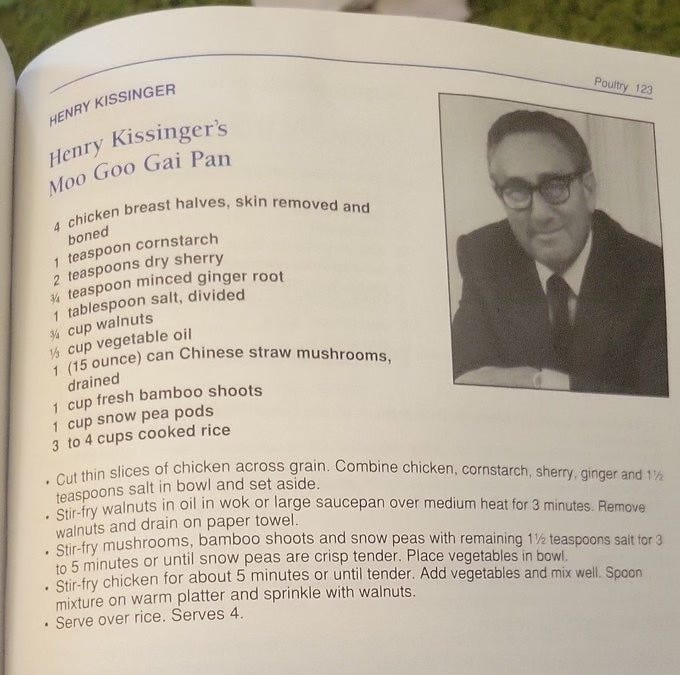
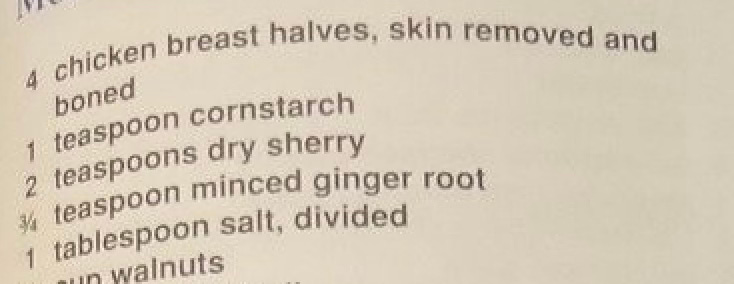

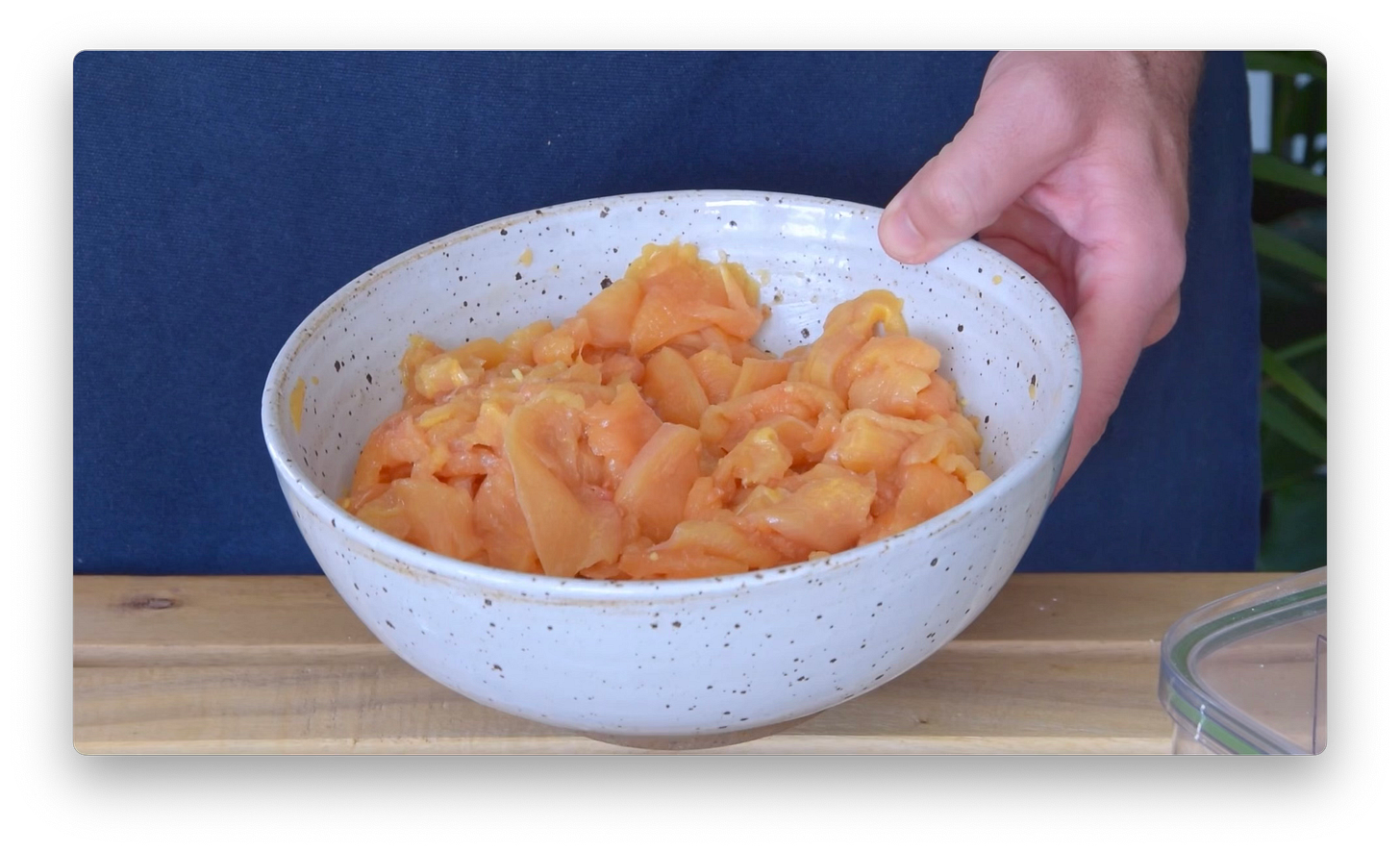




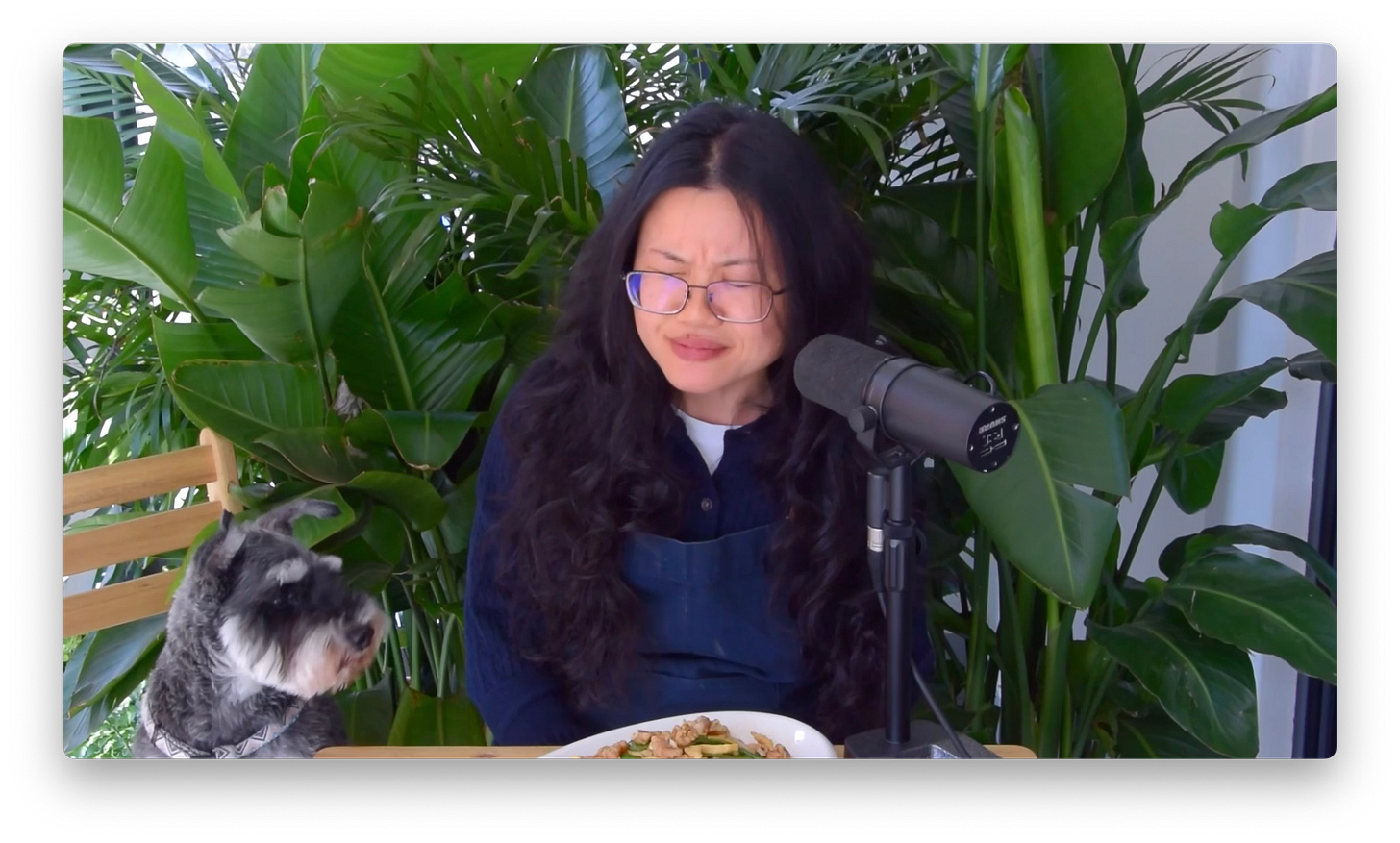
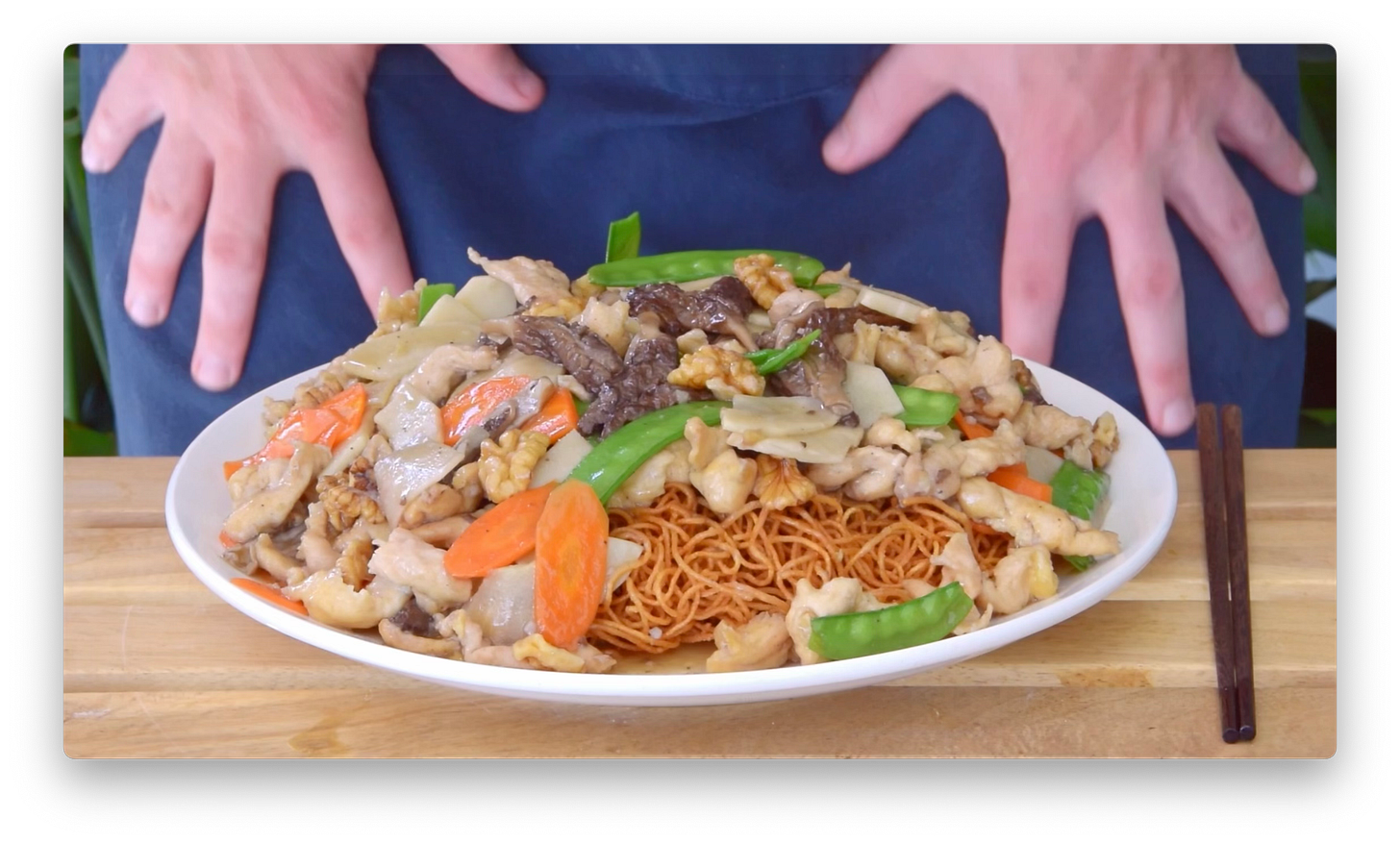
Instructions unclear, fatally undermined several Southeast Asian regimes. Awaiting further instructions on recovery.
Interesting,...thinking about the result, not so much. At least Hank was trying, but I'm in Anthony's generation, remember 'Nam all too well, and I'd not waste my hands beating on Hank...I'd use a club.